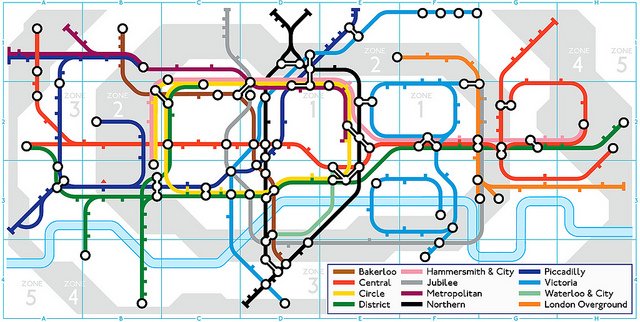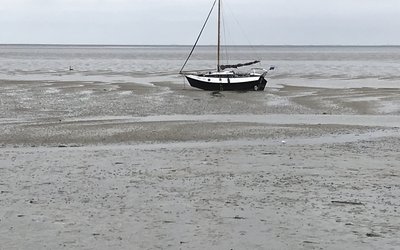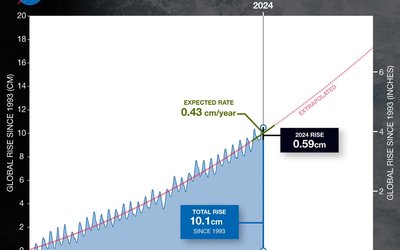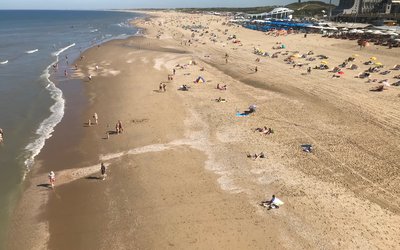Coastal erosion and coastal floods
How to decide on adaptation when the future is highly uncertain?
July 4, 2017

The timeline of adaptation pathways looks a bit like a subway’s map. Each strategy has a different colour, and the time step where a switch from one strategy to another has to be made is like a hub of metro lines (photo: Daniel Bowen, www.flickr.com)
The Third European Climate Change Adaptation Conference was held in Glasgow in June 2017, focused on “Our Climate Ready Future”. The ClimateChangePost presents a selection of contributions to this conference. This article is the fifth in a series of eight based on presentations given at the conference, and interviews with the scientists.
This contribution was presented by Marjolijn Haasnoot of the Netherlands’ research institute Deltares and Delft University of Technology.
In 1953 large parts of the Southwest of the Netherlands flooded and almost 2000 people lost their lives. Right after this disaster the Dutch started to strengthen their dikes and build storm surge barriers and dams. The completion of this so-called Delta Programme took about half a century. The Dutch know it takes a long time to implement the measures that are needed to safeguard the country’s high level of flood protection under climate change. Decisions have to be taken now on climate change adaptation strategies even though future projections of climate change, sea level rise, and socioeconomic developments are highly uncertain. Marjolijn Haasnoot of the Netherlands’ research institute Deltares specialized in decision making on climate change adaptation.
Adaptation pathways
She developed the so-called “Dynamic Adaptive Policy Pathways (DAPP)” approach. The essence of this approach is the fact that we don’t know a priori which actions are needed in the future, but we can explore the range of actions we can choose from under a wide range of futures, implement the actions needed on the short-term, and monitor to implement the longer-term options depending on how the future actually unfolds. A decision we take today, on actions or a certain strategy, might fail as conditions change. Sea level rise, for instance, may turn out faster or slower than we anticipate today. Once a strategy fails, a switch to another (portfolio of) action(s) is made to achieve objectives. This way a sequence of strategies (decisions) unfolds, that Marjolijn calls an ‘adaptive pathway’. ‘We can explore different pathways for different futures and thus design a flexible, adaptive plan’, she says. The plan is monitored for signals that indicate when the next step of a pathway should be implemented or whether reassessment of the plan is needed.
The timeline of adaptation pathways looks a bit like a subway’s map. Each action or portfolio of actions has a different colour, and the time step (“tipping point”) where a switch from one action to another, or the addition of another action has to be made is like a hub of metro lines. The advantage of this approach is its flexibility. You don’t have to draw up a new plan every time there are new insights into climate change or socioeconomic developments. You start of with a bundle of options at the beginning and adjust your strategies when needed.
Applied to the Rhine Delta case
This approach was introduced in the “new” Dutch Delta Programme, a nation-wide study to develop an adaptive Delta Plan to prepare the Netherlands for future climate and socio-economic change. ‘We started of with a theoretical concept and learnt that it can be applied in practice in different ways. You can use it to quickly explore your options, based on expert judgement, or for a more detailed assessment, based on model studies. You can tailor the approach to your objectives and resources’, Marjolijn explains. An important part of this is monitoring the signals on the basis of which you decide whether a switch to a different strategy is needed. Marjolijn: ‘It is extremely important to choose the right signals for monitoring. Those signals must be timely and reliable to implement actions on time but also convince policymakers and be indicative of new insights. Damage by droughts, for instance, may seem to be a good indicator to convince policymakers. This damage may be due to other impacts, however, and not necessarily indicative of climate change.’ Finding the right signals for monitoring is an important topic for the Dutch Delta Programme in the coming years.
Lessons learnt for other countries
Recently, the Bangladesh Government has formed a bilateral cooperation with the Netherlands to develop the Bangladesh Delta Plan 2100. This plan will be based on the “Dynamic Adaptive Policy Pathways (DAPP)” approach. The application to Bangladesh is somewhat different from the application to the Netherlands, however. In the Netherlands focus is on safeguarding flood protection and fresh water resources. In Bangladesh the application focuses on strengthening the country’s economic development, for example, by enhancing water security. Investments in water security need to be stress-tested against possible futures to ensure that they are robust and/or flexible to perform well. If they no longer perform well, adaption is needed.
Tailoring of the adaptive approach will be needed when used for another country. Not only the focus, also the available options and the context will be different. ‘Controlled flooding and accretion of floodplains, for instance, is an option for Bangladesh to (partly) keep up with sea level rise. This option is not realistic for the Netherlands due to all its embankments and lack of space. The Bangladesh landscape is more dynamic, and so are its people. They move to other parts of the country during floods, another option the Dutch don’t have’, Marjolijn explains. Bangladesh also differs from the Netherlands with respect to governance (five-yearly master planning in Bangladesh versus long-term thinking in the Netherlands), and the lack of data and integrated assessment models.
Following Bangladesh, Marjolijn and her colleagues have started to apply their approach in other parts of the world: to sea level rise and coastal adaptation in Miami, New Zealand and Australia, and to fresh water management in San Francisco.
Deep Uncertainty
Marjolijn describes her work as dealing with “Deep Uncertainty”. This issue is intrinsic to many disciplines, not just water management and climate change adaptation planning. A multidisciplinary group of professionals, working to improve decisions in our uncertain world, discuss their results and share lessons learnt. ‘For crisis managers, for instance, the available time to respond is highly uncertain and calls for an adaptive approach. Other partners in this group are transport and defence experts, for instance. Their methods are largely comparable to ours; we can learn from one another.’ This year the group will meet in Oxford. You can track their discussions on twitter (@deepuncertainty) or on their website www.deepuncertainty.org.








